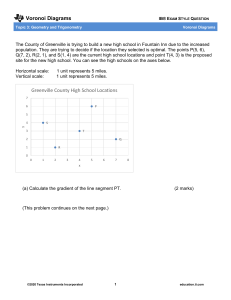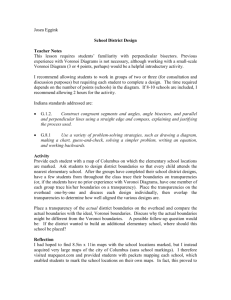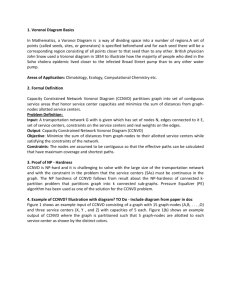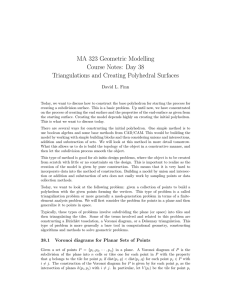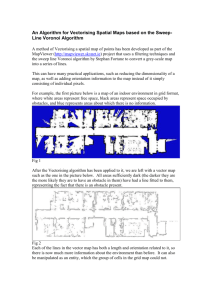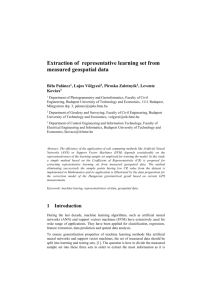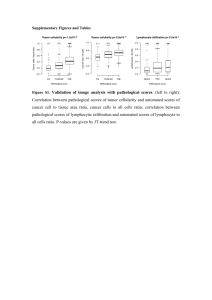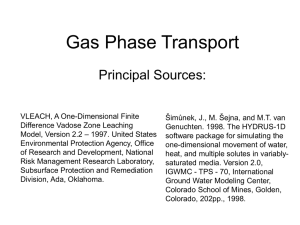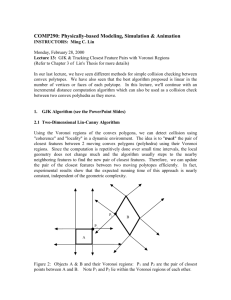Slides
advertisement
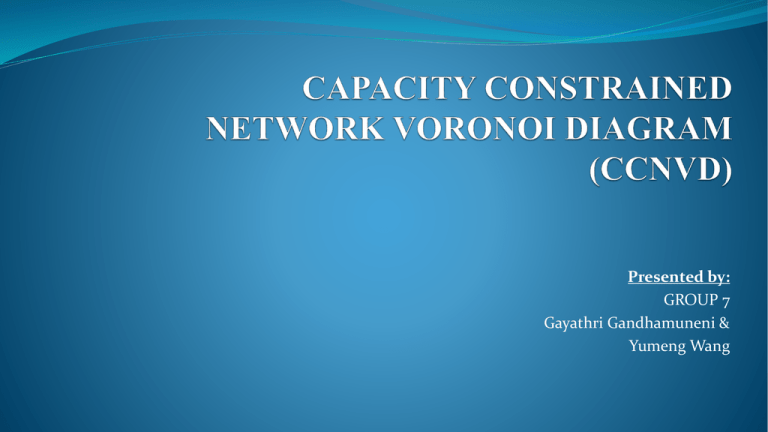
Presented by: GROUP 7 Gayathri Gandhamuneni & Yumeng Wang AGENDA Synonyms Definition Historical Background Scientific Fundamentals Key Applications Future Direction & References SYNONYMS CCNVD – None Voronoi Diagram - Voronoi tessellation, a Voronoi decomposition, a Voronoi partition, or a Dirichlet tessellation FORMAL DEFINITION Capacity Constrained Network Voronoi Diagram (CCNVD): Partitions graph into set of contiguous service areas that honor service center capacities and minimize the sum of distances from graph-nodes allotted service centers. SIGNIFICANCE & APPLICATIONS Critical Societal applications Examples: Assigning consumers to gas stations in the aftermath of a disaster Assigning evacuees to shelters Assigning patients to hospitals Assigning students to school districts CCNVD Finite Spaces Continuous Spaces PROBLEM STATEMENT Input: A transportation network G – (Nodes N, Edges E) Set of service centers Constraints on the service centers Real weights on the edges. Objective: Minimize the sum of distances from graph-nodes to their allotted service centers while satisfying the constraints of the network. Constraints: Nodes - Assumed to be contiguous The effective paths can be calculated (maximum coverage and shortest paths) Output: Capacity Constrained Network Voronoi Diagram (CCNVD) HISTORICAL BACKGROUND Voronoi Diagram: Way of dividing space into a number of regions A set of points (called seeds, sites, or generators) is specified beforehand For each seed, there will be a corresponding region consisting of all points closer to that seed than to any other Regions are called “Voronoi cells” RELATED WORK Minimizing sum of distances between graph nodes and their allotted service centers Honoring service center capacity constraints Min-cost flow approaches Service Area Contiguity CCNVD Network Voronoi Diagrams (NVD) RELATED WORK ILLUSTRATION WITH DIAGRAMS Input NVD RELATED WORK ILLUSTRATION WITH DIAGRAMS Min-Cost Flow without SA contiguity (min-sum=30)(Output) CCNVD (min-sum=30) (Output) – Pressure Equalizer Approach CHALLENGES Large size of the transportation network Uneven distribution - Service centers & Customers Constraint: Service areas must be contiguous in graph to simplify communication of allotments NP Hard FUTURE DIRECTION More factors of the problem into account Factors related to capacity of service centers, Example: Number and distance of neighboring nodes Service quality of the service center. Factors related to weight of each node Number of consumers The level of importance REFERENCES [1] KwangSoo Yang, Apurv Hirsh Shekhar, Dev Oliver, Shashi Shekhar: Capacity-Constrained Network-Voronoi Diagram: A Summary of Results. SSTD 2013: 56-73 [2] Advances in Spatial and Temporal Databases - 13th International Symposium, SSTD 2013 Munich, Germany, August 2013 Proceedings [3] http://en.wikipedia.org/wiki/Voronoi_diagram [4] Ahuja, R., Magnanti, T., Orlin, J.: Network flows: theory, algorithms, and applications, Prentice Hall [5] Goldberg, A.V., Tarjan, R.E.: Finding minimum-cost circulations by successive approximation. Mathematics of Operations Research 15(3), 430–466 (1990) [6] Klein, M.: A primal method for minimal cost flows with applications to the assignment and transportation problems. Management Science 14(3), 205–220 (1967) [7] Erwig, M.: The graph voronoi diagram with applications. Networks 36(3), 156–163 (2000) [8] Okabe, A., Satoh, T., Furuta, T., Suzuki, A., Okano, K.: Generalized network voronoi diagrams: Concepts, computational methods, and applications. International Journal of Geographical Information Science 22(9), 965–994 (2008) QUESTIONS? THANK YOU
